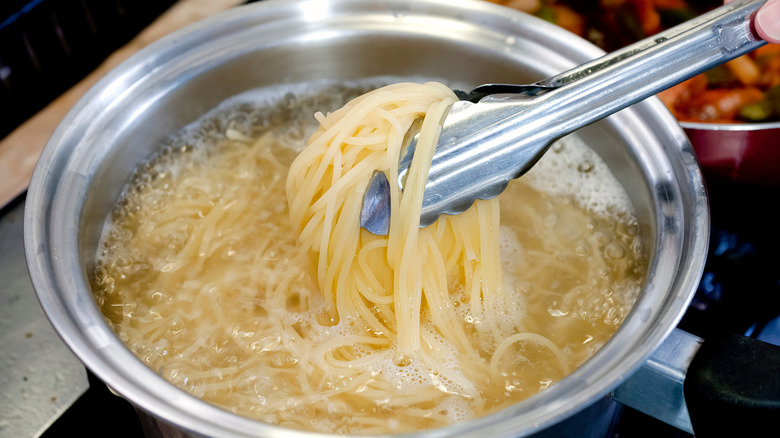Why Gordon Ramsay Never Completely Drains Pasta
Follow Gordon Ramsay's lead the next time you make pasta by putting its cooking liquid to good use. Rather than drain his pasta, he uses the leftover water to make restaurant-worthy dishes. In his YouTube video for easy 10-minute pasta, the chef makes an impressive sauce using lardons, garlic, chilis, peas, fresh herbs, and butter. The secret ingredient, however, is salty, starchy pasta water.
In the video, Ramsay makes the sauce while he boils spaghetti. Using a ladle, he scoops out a small amount of the pasta water and blends it into his sauce. This emulsifies with the fat from the bacon and butter to create a creamy, silky, and full-bodied sauce without the need for adding any more dairy. The key to creating the thick sauce is to not overly drain the noodles. In fact, Ramsay doesn't use a colander at all — instead, he uses tongs to transfer the cooked noodles directly into the sauce — along with the water that clings to the individual strands of pasta. For smaller shapes like penne or rigatoni, Giada De Laurentiis' tip for draining pasta without losing water is to use a pasta spider (a type of scooping strainer).
For this to work, you'll want to know what properly salted pasta water should taste like. Salt not only seasons but also acts to break up and release pasta's starch as it cooks. The resulting cloudy, starch-infused water flavors any sauce it's added to and turns separate ingredients into a cohesive dish.
More ways to use pasta water
Another reason to use pasta water is that the starch helps sauces stick, giving them a robust quality that binds well with noodles. That's why rinsing pasta is like washing liquid gold down the drain — you don't want to remove that clingy starch because it brings everything together. A number of Italian recipes rely on this process, such as cacio e pepe, carbonara, and fettuccine Alfredo, which traditionally are not made with cream ... it's actually the pasta water blended with cheese and butter which makes them so rich and creamy. Despite being a natural thickener, the fluid can also be used to thin out sauces like pesto without diluting their flavor or texture.
Pasta water can also elevate other types of food too. For example, it can be added to soups and stews to thicken them in place of the regular water or broth. This works especially well to add body to vegetarian soups that don't have chicken fat or other animal products to beef them up. Use it to instantly transform runny boxed mac and cheese, where it can replace milk for a fuller cheese sauce that better adheres to pasta.
Leftover pasta water also works wonders for homemade bread. The starchy water in combination with yeast will produce an excellent rise, and it improves bread's texture by softening it as well as binding it so that it doesn't crumble. It can even upgrade pizza crust by producing extra crispy results.


